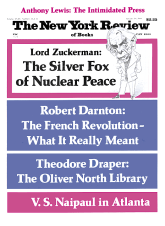In response to:
Whose American Renaissance? from the October 27, 1988 issue
To the Editors:
I was pleased by Frederick Crews’s generally positive comments about my book Beneath the American Renaissance in his essay-review “Whose American Renaissance?” [NYR, October 27, 1988]. I was appalled, however, to see my broad-ranging scholarship ultimately presented as a polemic against canon revision.
Crews creates an artificial polarization between me and some of my colleagues in the field (he calls them “the new Americanists”). As a young scholar politically shaped by the Sixties, I have an unflagging curiosity about noncanonical, forgotten literature, especially those of women and minorities. In my book I have unearthed a host of lost texts—many of them radical in theme and style—that I trust will now be considered by other scholars and the general public. Crews minimizes the fact that I’m the first to discuss such seriously radical, politically active authors as the suffragists Laura Curtis Bullard and Lillie Devereux Blake, the feminist Alice Cary, the antislavery novelist Richard Hildreth, the socialist George Lippard, the working-class author George Foster, and other progressive writers.
Perhaps some of the authors I’ve resurrected will, in time, be admitted into the canon. But canon revision doesn’t happen overnight; it takes comprehensive reading and longterm debate. My book was intended to illuminate some cultural roots of our familiar writers and to resurrect new texts for inspection by those interested in revising the canon. The critics Crews calls “radicals” should want to be the first to join me in studying these new texts. It only makes sense that in sifting through them we use coherent standards for separating the cultural chaff from the literary wheat.
David S. Reynolds
Rutgers University
New Brunswick, New Jersey
Frederick Crews replies:
Omnibus essay-reviews never do full justice to the works they touch on, but I thought I had come closer with David Reynolds’s book than with the seven others I considered. I did not characterize Beneath the American Renaissance as “a polemic against canon revision” but as a piece of “prodigious research” that “introduces us to a great many little-known and forgotten popular writings of the antebellum era.” That is just what Reynolds now wants us to bear in mind.
Reynolds hopes we will forget, however, that Beneath the American Renaissance inserts its acts of recovery into a rigidly deductive scheme of evaluation, whereby authentically “literary” antebellum works are distinguished from all others by their possession of certain uniform traits. In what he tellingly calls “the small group of literary texts,” for example, “ambiguity or mystery itself becomes a central issue consciously treated.” This means—and Beneath the American Renaissance repeatedly insists—that works failing to make ambiguity a conscious issue are ipso facto deficient in “literariness.” Such a position, automatically downgrading books such as Uncle Tom’s Cabin and Frederick Douglass’s Narrative, hardly anticipates the canon revision to which Reynolds now professes hospitality.
This Issue
January 19, 1989



